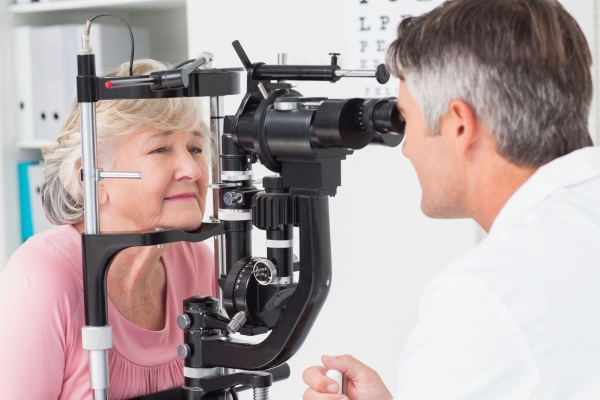The 5 Most Common Eye Injuries for Athletes
Sports and physical activities play a crucial role in maintaining a healthy lifestyle, but they also come with potential risks, including eye injuries

Glaucoma is relatively common, especially in older adults as it affects 2-3% of people over the age of 60. Although glaucoma is the leading cause of irreversible blindness for people over the age of 60, it can often be prevented with early detection and treatment.
In short, glaucoma is a disease that damages your optic nerve due to a build-up of pressure in the front part of your eye. As this nerve gradually deteriorates, blind spots develop in your peripheral vision initially and eventually also your central vision. Unfortunately, glaucoma can destroy your vision before you realise there’s a medical problem. That’s why it’s very important to be aware of the symptoms of glaucoma and ensure you book regular eye check-ups, especially if you are over the age of 60 and/or have a family history of glaucoma.
An analogy that best illustrates the cause of glaucoma, is to compare the eye to the air pressure of a ball. Just as a basketball or football needs air pressure to retain its shape and to stay firm, the eyeball needs the correct amount of internal fluid pressure to maintain its globe-like shape and ability to see. However, eye pressure can rise to dangerously high levels when something affects the ability of the internal eye structures to regulate its intraocular pressure (IOP).
When the pressure inside the eye is too high, unlike a football or basketball, the eye cannot relieve this pressure by deflating. Instead, this pressure continues building up and pushing against the optic nerve until nerve fibres are permanently damaged causing irreversible vision loss.
The underlying reason for this pressure build-up is dependent on the type of glaucoma you have. Given that glaucoma is technically defined as a group of eye diseases, not just one disease, it can be the result of a number of different factors and can exist in many forms.
1. Primary open-angle glaucoma
Open-angle glaucoma is the most common form of glaucoma. It happens when the eye’s drainage area is open, but the drainage sieve known as the trabecular meshwork is partially blocked. This causes the inner eye pressure to increase because the correct amount of fluid can’t drain out of the eye. This pressure damages the optic nerve. Since this damage occurs over a gradually most people have no noticeable symptoms and no early warning signs. If left untreated, however, this damage can cause permanent loss of vision.
2. Angle-closure glaucoma
The pressure rises because the entire drainage area blocks off. This results in an increased amount of fluid inside the eye, thus raising the intraocular pressure.
Angle-closure glaucoma may occur over time (chronic angle-closure glaucoma) or suddenly (acute angle-closure glaucoma). The acute form with a rapid rise of pressure can be very painful.
3. Normal tension glaucoma
Normal-tension glaucoma s a form of open angle glaucoma where the pressure inside the eye is not elevated above normal but the nerve is particularly sensitive and damage occurs anyway. Even with a normal pressure glaucoma lowering the eye pressure is protective. This type of glaucoma accounts for 25% of glaucoma cases and is more common in Asian nationalities and people who have a migraine or blood circulation problems.
4. Secondary glaucoma
Secondary glaucoma refers to any form of glaucoma in which there is an identifiable cause of increased eye pressure, resulting in optic nerve damage and vision loss. Secondary glaucoma usually develops due to a serious eye injury, cataract, tumour, inflammation, blood vessel blockage or diabetes.
5. Congenital and juvenile glaucoma
Although uncommon, it’s possible for infants and children to have glaucoma. It may be present from birth or developed in the first few years of life. In this case, the optic nerve damage may be caused by drainage blockages or an underlying medical condition.
The two most common types of glaucoma, open-angle and acute angle closure glaucoma, have very different symptoms. Open-angle glaucoma often has no major symptoms other than gradual peripheral vision loss characterised ultimately by tunnel vision. On the other hand, acute angle-closure glaucoma, although rare, is classified as a medical emergency and presents itself with eye pain, often accompanied with nausea and vomiting. Other symptoms include sudden development of visual disturbance, blurred vision, halos and reddening of the eye.
Early detection of glaucoma is important because the disease is treatable and vision loss can be prevented if it is caught in time. Treatment is with drops, laser procedures and occasionally surgery.

If you’re over age 60 and have a family history of the disease, you should have a complete eye exam from an eye doctor every 1 to 2 years. Early diagnosis and treatment is the key to preserving sight in people with glaucoma, therefore regular eye checks are the best form of glaucoma-damage prevention.

Sports and physical activities play a crucial role in maintaining a healthy lifestyle, but they also come with potential risks, including eye injuries

For those leading an active lifestyle or engaged in sports, the significance of clear vision cannot be overstated.

Uncover the revolutionary technology behind LASIK that has empowered millions to enjoy clear vision without glasses.